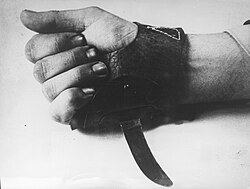This is an old revision of this page, as edited by Rjecina (talk | contribs) at 02:29, 11 May 2008 (reverting (restoring tags) banned user). The present address (URL) is a permanent link to this revision, which may differ significantly from the current revision.
Revision as of 02:29, 11 May 2008 by Rjecina (talk | contribs) (reverting (restoring tags) banned user)(diff) ← Previous revision | Latest revision (diff) | Newer revision → (diff)
Srbosjek (literally serb-cutter in Croatian, often mentioned as cutthroat) was a specially designed knife, used mostly for speedy slaughter of Serbs and other victims by the Croatian Ustaše fascists during World War II in the Independent State of Croatia, an Axis puppet state.
This knife was manufactured during World War II by German factory Gebrüder Gräfrath from Solingen-Widderit (which is still in existence today, albeit under another name) under a special order from the NDH government, and was used for slaughter of Serbs, Jews, Roma and Croats opposed to the regime in organized mass murders at the concentration camp Jasenovac and other places.
The upper part of srbosjek is made of leather, as a sort of a glove, designed to be worn so that the thumb goes through the hole, so that only the blade protrudes from the hand. There was inscription "Gräwiso" on the leather part of the knife. The blade is curved in order to make it easier to slit the throat of the victim, following the curvature of the neck.
The Srbosjek knife was allegedly designed after Ante Pavelic ,held a session of his government, where one of the items on the agenda was what kind of a knife should be designed to make it possible for the executioners to kill people as fast as possible and with as little fatigue as possible.
References
- Religious Separation and Political Intolerance in Bosnia-Herzegovina by Mitja Velikonja, Texas A&M University Press pages 32, 327
- The Library of Congress World War II Companion by David M. Kennedy, Margaret E. Wagner, Linda Barrett Osborne, Susan Reyburn; Publisher: Simon and Schuster, 2007 pages 640, 646-47
- Jasenovački logor smrti, dr Nikola Nikolić, 1948
- ^ Takozvana NDH, dr Mladen Colic, Deltapres, Beograd 1973
- Vatikan i Jasenovac, Vladimir Dedijer, Dokumenti (Beograd: “Rad”, 1987)